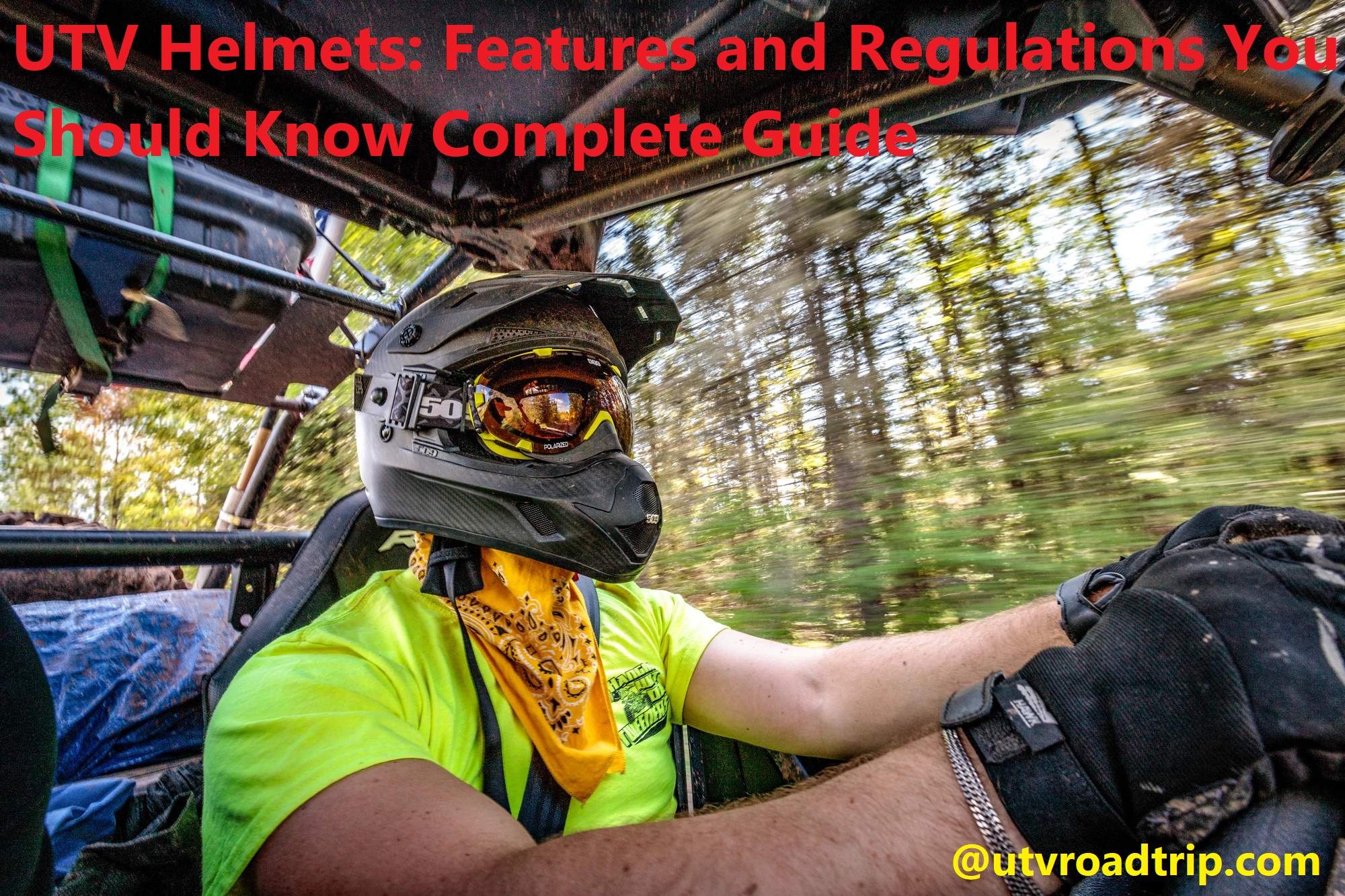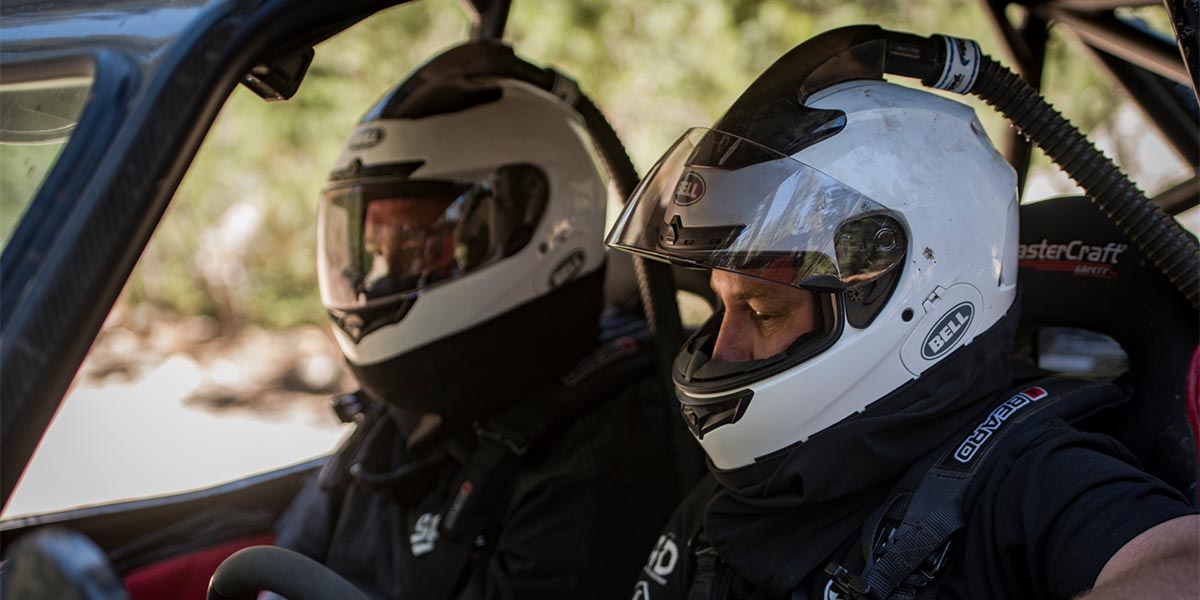Do you feel overwhelmed when thinking about the regulations and features of UTV Helmets? We understand the confusion about the safety measures needed for UTV riding.
In this article, we will talk about all the necessary regulations and features of UTV Helmets to help you make an informed decision. You’ll be ready to choose the perfect helmet for your next ride in no time!
Welcome to the complete guide for understanding UTV helmet features and regulations. This guide is designed to provide an in-depth understanding of the safety standards and features associated with helmets for UTV riders. In this guide, we will cover everything from the certified safety standards of helmets, the essential design features and materials used to produce them, helmet fitment advice, DOT certification requirements, and much more.
By exploring this comprehensive resource, you’ll gain a better understanding of UTV helmet use regulations; be able to identify compliant safety helmets; obtain a better knowledge of how to buy and find the right fitment; learn about impacts on sound and vision with different style helmets; understand up-to-date DOT regulation requirements for offroad riders. So whether you’re new to UTV off roading or an experienced rider looking for a refresher on helmet features and recommendations – this guide will have all you need!
Features of UTV Helmets
UTV helmets come in a variety of styles and features, ranging from basic and utilitarian to all-out performance models. Here we’ll provide an overview of the features you should look for when purchasing a UTV helmet.
Fit: UTV helmets are generally larger than traditional bike or open-faced helmets, as they need to be able to accommodate the extra headroom that comes with an enclosed cab. Look for a helmet that fits your head comfortably, but not too tight or too loose.
Aerodynamics: UTV helmets tend to be designed with a “dual action” aerodynamic system – meaning they are designed to reduce drag on the upper and lower portion of the helmet. Look for helmets with an aerodynamically efficient shape, such as those developed by brands like Arai or Simpson.
Visor/Goggle System: The majority of UTV helmets come equipped with either a visor system or goggles. Visors generally provide better peripheral visibility, but some choose goggles for full eye protection and increased airflow into the face area. Make sure the system you choose is compatible with your helmet model and is adjustable to fit your eye size and shape.
Ventilation System: A good ventilation system will keep you cool in hot temperatures while also preventing fogging of your visor/goggles while driving in wet conditions. Look for large vents on both the top and bottom portions of the helmet as well as exhaust vents located near the base rim around your neck area; these create a steady flow of air that removes heat from inside the helmet cavity while leaving minimal pressure on your head at high speeds.

Safety standards and certifications
Safety is paramount when considering the use of a UTV. While most people understand the importance of wearing a helmet, there are also specific safety standards and certifications that a helmet should meet in order to protect the wearer while in use.
There are several regulatory bodies that set safety standards and certify helmets for use on UTVs. These include the American National Standards Institute (ANSI), the Serial Authority of Canada (SAC), and The Snell Memorial Foundation. Each has their own specific set of safety criteria, but all three look at how effective a helmet is in protecting against potential head injuries. The criteria includes impact testing, penetration resistance testing, chin guard strength testing, field of vision tests and more.
In order to ensure that a helmet meets these safety criteria, it should be certified by one or more of these bodies before it can legally be used in the USA or Canada. This certification is usually printed on either inside or outside of the helmet. Make sure you look for this when purchasing your UTV helmet as it will provide you with assurance about its levels of protection against head injuries.
Helmet materials and construction
The construction of UTV helmets is essentially the same as for other types of helmets. There are three parts to a helmet: an outer shell, an impact-absorbing liner, and a comfort liner.
The outer shell is typically made from composite materials such as fiberglass or Kevlar-reinforced plastic (FRP). It absorbs the initial impact of objects hitting the helmet and spread it out to minimize the shock on your head and neck.
The impact-absorbing liner is usually made out of expanded polystyrene (EPS) foam. This foam can absorb an impressive amount of energy in an impact without cracking or breaking.
The last layer, the comfort liner, is designed to provide comfort while wearing the helmet. It also serves to hold everything together and helps keep your head cool while riding.
Regulations for UTV Helmets
As important as it is to find the right helmet for your specific UTV driving habits, there are also a few regulations you should consider before purchasing. Each state in the United States has its own set of rules and regulations, so be sure to check with your local Department of Motor Vehicles (DMV) before making a purchase.
Here are some of the most common factors that you should take into consideration when shopping for a UTV helmet:
Age: In most states, it’s illegal for anyone under the age of 18 to ride an off-highway vehicle or ATV without wearing an approved safety helmet.
DOT Approved: All street legal UTV quad helmets must meet at least one certification standard from either the Department of Transportation (DOT) or Snell Memorial Foundation. Most reputable bike stores will only sell DOT-certified helmets, however you can find Snell-certified helmets online and through specialty retailers.
Safety Features: Your UTV helmet should have all the necessary safety features – such as a quick release strap, chin protection, and interior padding – to effectively protect your head in case of impact or sudden movements. Many UTV helmets also come with additional features such as fog and UV-resistant visors and other eye protection features.
Helmet Graphics: Some states forbid drivers from operating vehicles while wearing helmets that contain certain written statements or graphics which can distract other drivers on the road/track. Be sure to check local restrictions before choosing any printed motorcycle curtains for your helmet.
Federal regulations
It is important to understand the federal regulations that are in place for helmets when it comes to operating a UTV. The Consumer Product Safety Commission (CPSC) has safety standards in place for all helmets, including off-road and UTV helmets. These standards are in place to protect consumers from head injury, and they require that the helmet must adequately protect a person’s head when it is impacted by an object of up to 10 lbs. Additionally, all helmets must also pass a variety of impact attenuation tests and should be labeled with the manufacturer’s name or identification along with expiration date.
Before you purchase a helmet for your UTV, you should check and make sure it meets CPSC safety requirements. It should also be comfortable for long periods of time, since you will be wearing your helmet for extended periods of time while riding your UTV. Your helmet should fit securely without being too tight or too loose on your head; ideally, it should fit snugly but allow enough room that you can easily move your jaw up and down while keeping your lips slightly apart.
Also take note that while most states do not have specific laws regarding UTV operator age restrictions, riders do need to abide by any local laws pertaining to helmet use – these can vary by county or state – so be sure you are properly informed before heading out on the trails!
Choosing the Right UTV Helmet
When it comes to choosing the right UTV helmet, there are a few key features and regulations you should consider.
First, make sure you select the correct size for a snug and comfortable fit. Most UTV helmets come in XS-XL sizes, but there may be specific deviance from one brand to another so it is important to check their sizing chart.
Second, check for any necessary certifications that your helmet must have when riding on the trails. In the United States and Canada, UTV helmets are often D.O.T certified or Snell Annex M Certified for compliance with safety standards. Additionally, many have extra specs such as MIPS designed to further improve helmet impact protection against rotational forces that can cause brain injuries in case of crashes.
Finally, make sure your UTV helmet offers features that help you stay safe and comfortable while driving such as adjustable venting systems or sun screens to shield your face from harmful UV rays while driving out on the trails. All of these factors contribute to a better overall riding experience when selecting the right UTV helmet for safety and comfort!
Matching the helmet to your riding style
When shopping for a UTV helmet you’ll need to consider your personal riding style, the terrain you’ll be traveling and your preference for safety products — such as safety ratings assigned to helmets by regulatory agencies. Different types of helmets provide varying levels of protection, so it is important to choose one that matches your riding style and the environment in which you are riding.
There are several key features one should consider when selecting a UTV helmet: Comfort, Ventilation, Visibility, Weight and Safety Ratings.
Comfort – Helmets come in different styles that may fit one person better than another. It’s important to go try on several different types before purchasing one. Be sure to check how the padding fits around your head and how the chin straps fit. Ensure it doesn’t press too hard or slip off easily.
Ventilation – Proper ventilation protects you in hot weather rides where temperatures can exceed 100° F (37° C). Look for vents built into the design of the helmet that can provide airflow or breathability while you drive.
Visibility – When operating a UTV, being able to see properly is essential for safety reasons. Many helmets have adjustable vents so you can change the amount of air entering the vents depending on weather conditions and visibility requirements.
Weight – Heavier helmets often offer more protection but can be cumbersome if not comfortable enough for extended periods of use during a ride. It is recommended to select helmets with lighter materials such as injection-molded plastic which offer levels of stiffening as well as comfort and lightweight options like carbon-fiber which provide strength despite their light weight attributes.
Safety Ratings – A regulatory agency may provide safety ratings for UTV helmets based on impact tests done on various models in various speeds and environments (dry asphalt, wet pavement). Look into these ratings before making a purchase — they will tell you how much shock absorption the helmet provides if involved in an accident while wearing it. The higher its rating generally indicates better protection against impact related injuries due to crashes or falls while driving your UTV vehicle.

Proper fit and sizing
Getting the right fit is one of the most important aspects of buying a helmet. Whether you’re selecting an ATV or UTV helmet, be sure to follow all sizing instructions included with your product.
Helmets should fit snugly, but still be comfortable enough for prolonged wearing periods. Your helmet should not slide around on your head if you make quick head movements, and the chin straps must be secured prior to use. When wearing a helmet with its visor in place, users should be able to maintain full peripheral vision without having to crane their neck in any way.
It’s also important to understand how helmets are sized and what’s included in those numbers that manufacturers use. Helmets come in sizes from XS small through 3XL extra large and beyond for those who need larger-sized wearqables due to large heads or other physical anomalies. For UTV helmets, these sizes are offered as Small (57 cm to 59 cm), medium (59 cm – 61 cm), Large (61 cm – 63cm) and X-Large (63cm – 65cm). Manufacturers may also offer smaller sizes intended for smaller ATVs or children’s models while motorcycle models typically feature larger sizing ranges that may include XXL and XXXL options.
Before purchasing a new helmet, take measurements of your head circumference at the widest point above your brow line while standing with full posture and no hair obstructing the measurement site. The measurement is best taken with a ribbon or soft cloth tape measure – plastic measuring tapes often offer inaccurate results due to stretching properties – Write down this measurement as it will vary from manufacturer-to-manufacturer depending on their sizing guidelines –at which point you are ready for shopping!
Maintaining and Caring for Your UTV Helmet
To maintain the condition of your helmet, proper cleaning and storage are essential. When cleaning your UTV helmet, use a damp cloth and mild soap. Do not use harsh detergents that may damage the surface of your helmet shell. After cleaning it, you should use a soft cloth to dry it and a silicon-based protector to protect its outer surface from oxidation or color fading caused by ultraviolet light. Additionally, storing helmets inside a cool dry place away from direct sunlight can also help extend their lifespan.
You should regularly check the condition of your UTV helmet over its lifetime. Look closely at the shell for scratches or any dents which might indicate an internal problem. Check all buckles and straps for any signs of wear and tear, cracking, fading or rusting – if you see any of these signs then you should replace them immediately with brand new components from your retailer or the original helmet manufacturer. Make sure that all safety labels are still intact when inspecting your helmet as well – these labels inform you about important information about the manufacturer’s standards for fitment and safety requirements for long-term safe operation.
Cleaning and maintenance tips
Whether you are a novice to the wonderful world of UTVs (utility terrain vehicles) or an experienced hotshot, maintaining your UTV is of utmost importance. Cleaning and maintenance of your UTV helmet should be included in your regular maintenance routine. It’s worth taking the time to properly clean and maintain your helmet to ensure maximum safety as well as its longevity.
Your UTV helmet should be carefully wiped down after each use with a clean, dry cloth. Helmet liners should be hand washed in cold water using a mild detergent. Never put your helmet in the washing machine or dishwasher as this will cause damage to the materials used. Therefore, it’s best to handle cleaning manually for longer lasting results and for more effective sanitation when necessary.
It’s also important to inspect all straps, latches, vents and parts such pins, bolts before each use and regularly check that they remain securely closed. Vents should be kept clean on both the inside and outside surfaces every few days or after each use depending on how much dirt accumulates on them during operation. If spots persist on these areas they can be effectively cleaned with a damp cloth gently rubbed over them without saturating any materials present in the construction of helmet design- this may include metal clips, leather straps or plastic buckles taking extra care on coated parts where applicable. Any foreign matter like leaves must also be removed from exterior surface of the helmet regularly-usually weekly checks suffice here too as forces exerted by off-road driving conditions tend move branches around frequently clearing surface dirt away quite quickly.
In order for parts like vent covers & removable pads/visors functional life these items will require replacing at some point depending how much abuse they are subjected too this is usually noted within recommended cleaning schedule given with each product they may come also manufacturer guidelines available online so take heed! Ultimately routine maintenance along with respect limits of terrains that one is operating or extent activity -whether racing leisure runs – will significantly prolong lifespan any protective gear including helmets course player decision operate safely always paramount!
When to replace your helmet
It is important to replace your helmet if there is any visible sign of wear and tear such as scratches or sunlight damage. Helmets have a maximum lifespan of around three to five years, after which they should no longer be considered safe.
Additionally, your helmet should be replaced if you have been in a crash as the helmet has absorbed impact and can no longer guarantee sufficient protection. To make sure that your UTV Helmet fits safely, it is also advised to replace it when outgrowing the size previously used.
Conclusion
Now that you’ve gone through the details of UTV helmets, you are well informed on what features to look for, the different helmet types available, as well as the regulations and safety guidelines involved.
By understanding these topics, you can make an informed decision when it comes to selecting a helmet for your UTV. Keeping safety as a priority is paramount when using any motorized vehicle and investing in a quality UTV helmet is an essential part of that mission.
Take an extra step in protecting yourself and loved ones by making sure you have the right gear before moving off-road.

FAQ’S
What type of helmet is best for UTV?
A full-face helmet is generally the best choice for UTVs, as it offers the most protection and coverage.
Do you need a helmet for a UTV?
In many states and countries, wearing a helmet is required by law when driving a UTV or other off-road vehicle.
What are the safety regulations for helmet?
Safety regulations for helmets can vary by location, but generally they include requirements for impact resistance, retention systems, and other safety features.
What are the features of a good helmet?
Features of a good helmet can include good fit, proper ventilation, high-quality construction, comfortable padding, and effective impact protection.
How should a UTV helmet fit?
A UTV helmet should fit snugly but comfortably, with no gaps between the helmet and the head. It should not be too tight or too loose.
Should helmet be light or heavy?
A helmet should be light enough to be comfortable to wear, but heavy enough to provide effective impact protection.
What are the three types of helmets?
The three types of helmets are full-face helmets, open-face helmets, and half helmets.
Which is better single or dual visor helmet?
A dual visor helmet can offer better versatility and protection than a single visor helmet, but the choice ultimately depends on personal preference.
How do I choose the right helmet?
To choose the right helmet, consider factors such as fit, comfort, ventilation, weight, and safety features. It’s also important to choose a helmet that meets your specific needs and riding style.
What is the number 1 helmet?
There is no definitive “number 1” helmet, as different helmets can be better suited to different riders and situations. It’s important to choose a high-quality helmet that meets your individual needs and preferences.
See Also :
- Best 12 volt heater for utv
- Best utv tire for trail and mud
- Best all around utv tire
- Best utv tires
- Best all terrain utv tires


